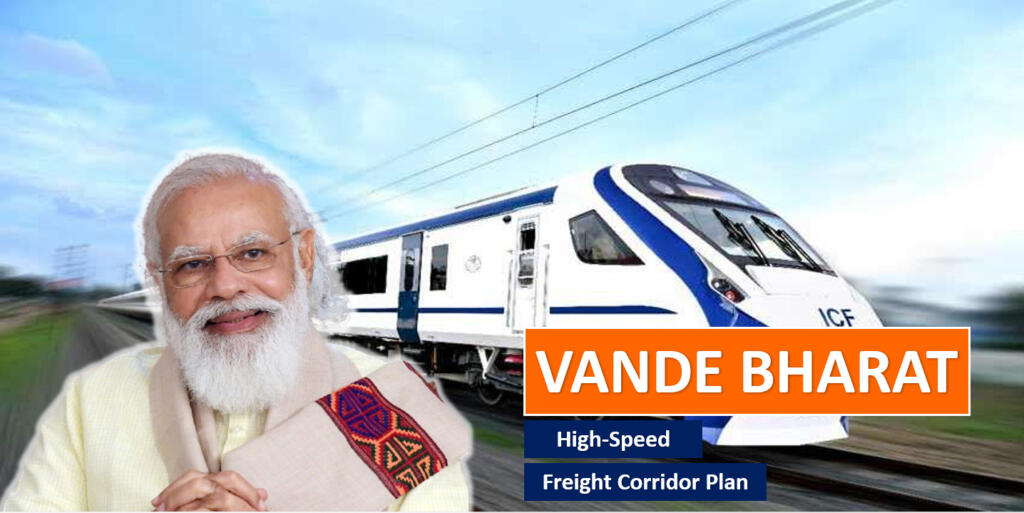- Modi government has decided to launch freight trains on the lines of Vande Bharat trains
- This will help freight trains get more avenues for increasing their market share in India’s logistical journey
- With the increase in other infrastructure segments like Roads and waterways, E-commerce sector is the new avenue which Railways can serve
Ever since the Modi government came to power, it has been subject to jibes like Suit boot ki Sarkar amongst others. But, the fact of the matter is that no government has done more to make service delivery more accessible to the last mile than the one currently headed by BJP. The next instalment of this rapid growth is a push for High-Speed Freight Corridor.
Freight metros to be launched by Modi government
The fate of freight being transported through trains is going to be revolutionised in India. The Modi government has planned to introduce high-speed Freight Trains on Indian Railways’ tracks. These trains will be built on the lines of Vande Bharat trains currently used to deliver passengers to and fro from Delhi to Varanasi and Shri Mata Vaishno Devi Katra.
According to reports available in the public domain, the Government will launch 25 such trains as a pilot project. Each of these trains will have 16 cars. Currently, the freight trains running in India have an average speed of 75 kmph. However, the new trains to be introduced will be running at the speed of 160kmph. According to experts quoted by media houses, the increased speed will help Railways increase its share in freight logistics to 40 percent of the overall market.
Currently, Indian Railways carries only about 28 percent of goods being transported in the country.
Read more: After Indian Railways’ Vande Bharat, India’s standards are now an international benchmark
Will cater to E-Commerce sector
One remarkable aspect about these new high-speed freight trains, also popularly termed as ‘Freight Metros’ is that they will radically improve the delivery experience of customers of e-commerce companies. According to a report by Economic Times, Railways is planning to deploy these trains on the busiest routes to increase their efficiencies. These trains will target the delivery sector of E-commerce giants like Amazon, Flipkart and others.
An officer quoted by Economic Times said, “As the new freight trains will run on Railways’ most lucrative routes connecting the metros and other big cities in a time-tabled manner, our target will be to carry parcels of companies such as Amazon and Flipkart. With this train, the Railways will be about 2.5 times faster than road carriers, and in certain sectors, we will even compete with air cargo carriers.”
The prototypes of these trains are expected to be prepared by December this year. After that, the government will deploy them in a phase-wise manner with one such ‘Freight metro’ every month. Individually, one train will cost Rs 60 crore each to the state’s exchequer.
Read more: Indian Railways’ big move to make trains “collision-free”
Revival of freight trains
Freight trains have been one of the backbones of India’s demand-driven economy. According to a report by Statista, a total of 7,000 freight trains assist in carrying over 3 million metric tonnes of freight per day. In the year 2020, Indian freight trains carried over 1.2 billion metric tons of goods from one location to another. However, a constant lower speed of delivery has been one problem miring the Railways freight trains from the beginning. In 2021, railway freight trains ran at an average speed of only 43.2 km per hour. Basically, an efficient truck driver could deliver parcels at a better speed than an average Indian freight train in 2021.
Up until now, Freight trains delivered only a few categories of products to the hinterlands. Coal and Coke, Mineral and Ores, Cement and clinker are some of the most prominent products delivered by freight trains. The sector which has benefited most from Railways is Fertiliser. About 85 percent of fertilisers produced inside as well as imported inside the country are transported to farmers.
However, with the rapid development of roadways and waterways under the Modi government, it became imperative for the Railways’ freight network to improvise and adapt to the changes. According to a 2021 report by Financial Express, e-commerce is growing at an annual rate of 51 percent. It is projected to tick $200 billion by 2026. E-commerce and its increasing market share, as well as competition coming up with it, is providing a much-needed opportunity for Railways to ramp up its growth trajectory.
